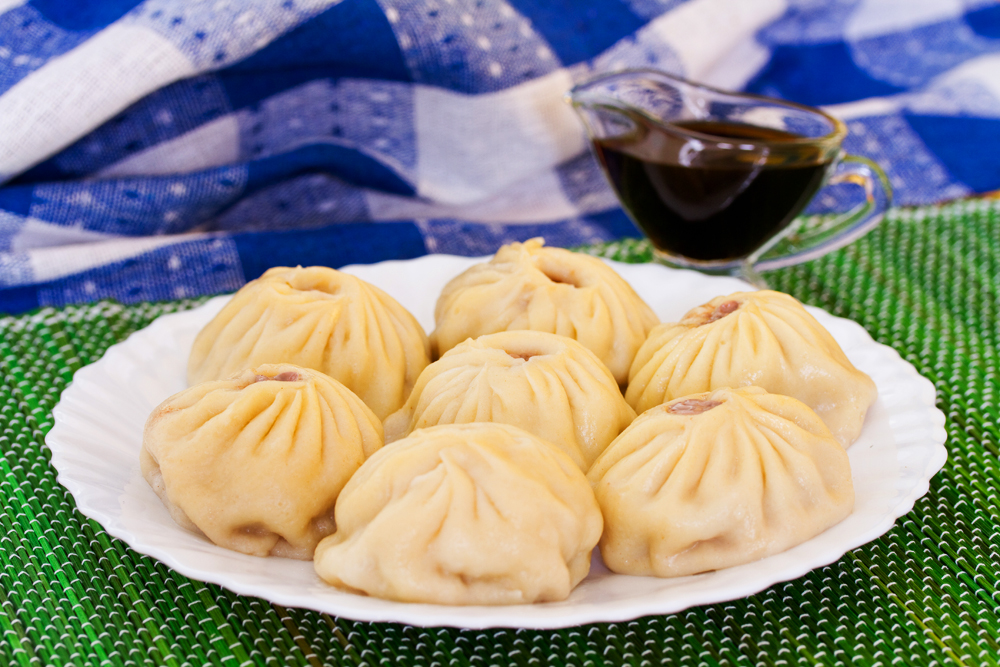
Pozy, steamed meat dumplings, a traditional dish of Buryat and Mongolian cuisine.
Lori / Legion-MediaPerm: the discreet charm of posikunchiki
If you are travelling to Perm (1,154 kilometres from Moscow) for the first time, a question that will arise is, “What are posikunchiki?” These snacks are available virtually everywhere in the Perm region and northwest of the Sverdlovsk Region, though unknown almost everywhere else. A traditional dish in the Urals, posikunchiki are small fried pastries with a spiced minced meat and onion filling. They resemble “chebureki,” (deep-fried turnover filled with meat), but are smaller. Connoisseurs of Italian cuisine will notice a definite resemblance to “panzerottini” (similar to a closed pizza), small “calzoni” with tomato and mozzarella or meat filling, found in Apulia and which, like posikunchiki, should be eaten with your hands. There are many places in Perm to try posikunchiki, but the most delicious ones are available at “Postoyaly Dvor,” a small restaurant in the picturesque village of Khokhlovka (45 kilometres north of Perm). It is the ideal place for a bite after visiting the nearby open-air Museum of Architecture and Ethnography.
Russia is not an easy country for vegetarians. Things are, however, rapidly changing. If you visit Yekaterinburg, the main city of the Ural region (1,417 kilometres from Moscow), take a walk along ul Vainera, a lively pedestrians only street and drop in at Rada, a cosy vegetarian café on the first floor of the “Krasny Leopard” shopping centre. A wide range of vegetarian dishes are available from across the world (including Georgian lobio and West Asian falafel), along with a delightful selection of meatless versions of popular dishes (plov, bigos and lasagna) and pastries.
Irkutsk, “the Paris of Siberia” (4,202 kilometres from Moscow), is a must for all Trans-Siberian travellers, with its splendid baroque churches and colourful architecture. During a break from sight-seeing, you’ll find a comfortable shelter at Govinda, a vegetarian café in the centre that boasts of being the first of its kind in town. Although Govinda is small and the list of dishes is not very long, it has a very pleasant atmosphere. Try the delicious vegetarian goulash or desserts, as much a delight for the eyes as for the stomach.
Pozy: taste of the steppe on Lake Baikal
Once you’ve reached Lake Baikal, there is no way that you won’t encounter ‘pozy’, which are everywhere. Also known as “buuza” (in Buryat) or “buuz” (in Mongolian), these steamed meat dumplings make up the most famous traditional dish of Buryat and Mongolian cuisine. In Buryatia there are even festivals devoted to them.
Pozy are similar to Chinese dumplings (bao-dzi), and look like the Georgian “khinkali” and Tatar and Central Asian “manty.” They are salted meatballs of minced mutton or beef, seasoned with herbs and garlic or onion and folded into a pocket of dough with an opening at the top. Similar to ‘khinkali’, these should be eaten with the hands and the sauce inside drunk after the first bite. If your trip includes a stay in Khuzhir, the biggest village on Olkhon Island (4,335 kilometres from Moscow), drop in at Yurta, a cafe located on ul. Pushkina. As the name suggests, this is a very small café located in a wooden yurt. Don’t let the modesty of the exteriors deceive you: this is one of the best places in town and its pozy are delicious.
If feeling drowsy after eating too many pozy, cross the street to the wooden house with the painting of an old bearded man on its wall. Welcome to Khuzhir’s Art-Café, where you will find what is probably the best cappuccino east of the Urals. Sip your coffee on the upstairs terrace and enjoy the gentle breeze and soft music in the background.
Whether you’re beginning or ending your Trans-Siberian journey in Vladivostok (6,416 kilometres from Moscow), a good way to say farewell to Russia’s Pacific gates is to visit the Tokarevsky Lighthouse, located at the edge of the Gulf of Peter the Great. On your way there (or back) you can stop at Goryanka, a restaurant specializing in Karachay cuisine. Karachay food may not be as well known as Georgian or Armenian (it has shashlyk kebabs and spicy meat soups in common with them), but it does have its own masterpiece: ‘khychiny’ or big round pies similar to Georgian ‘khachapuri’. Khychiny are filled with either meat and herbs or potatoes and cheese and are extremely filling. All kinds of khychiny are good here, but the simple meat and vegetable soups are also worth trying. It is often crowded here, but the lively ambience in the summer terrace make it worth the wait.
All rights reserved by Rossiyskaya Gazeta.
Subscribe
to our newsletter!
Get the week's best stories straight to your inbox